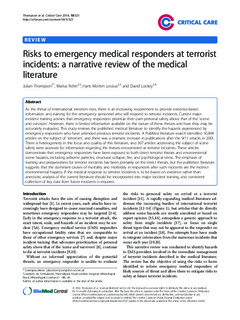| dc.contributor.author | Thompson, Julian | |
| dc.contributor.author | Rehn, Marius | |
| dc.contributor.author | Lossius, Hans Morten | |
| dc.contributor.author | Lockey, David | |
| dc.date.accessioned | 2017-02-01T13:38:26Z | |
| dc.date.available | 2017-02-01T13:38:26Z | |
| dc.date.issued | 2014-09 | |
| dc.identifier.citation | Thompson, J. et al. (2014) Risks to emergency medical responders at terrorist incidents: a narrative review of the medical literature. Critical Care, 18:521 | nb_NO |
| dc.identifier.uri | http://hdl.handle.net/11250/2429170 | |
| dc.description.abstract | As the threat of international terrorism rises, there is an increasing requirement to provide evidence-based information and training for the emergency personnel who will respond to terrorist incidents. Current major incident training advises that emergency responders prioritize their own personal safety above that of the ‘scene and survivors’. However, there is limited information available on the nature of these threats and how they may be accurately evaluated. This study reviews the published medical literature to identify the hazards experienced by emergency responders who have attended previous terrorist incidents. A PubMed literature search identified 10,894 articles on the subject of ‘terrorism’, and there was a dramatic increase in publications after the 9/11 attacks in 2001. There is heterogeneity in the focus and quality of this literature, and 307 articles addressing the subject of scene safety were assessed for information regarding the threats encountered at terrorist incidents. These articles
demonstrate that emergency responders have been exposed to both direct terrorist threats and environmental scene hazards, including airborne particles, structural collapse, fire, and psychological stress. The emphasis of training and preparedness for terrorist incidents has been primarily on the direct threats, but the published literature suggests that the dominant causes of mortality and morbidity in responders after such incidents are the indirect environmental hazards. If the medical response to terrorist incidents is to be based on evidence rather than anecdote, analysis of the current literature should be incorporated into major incident training, and consistent collection of key data from future incidents is required. | nb_NO |
| dc.language.iso | eng | nb_NO |
| dc.publisher | BioMed Central | nb_NO |
| dc.rights | Navngivelse 4.0 Internasjonal | * |
| dc.rights.uri | http://creativecommons.org/licenses/by/4.0/deed.no | * |
| dc.subject | emergency medical services | nb_NO |
| dc.subject | emergency medical responders | nb_NO |
| dc.subject | terror | nb_NO |
| dc.subject | terrorist incident | nb_NO |
| dc.subject | terrorhandlinger | nb_NO |
| dc.title | Risks to emergency medical responders at terrorist incidents: a narrative review of the medical literature | nb_NO |
| dc.type | Journal article | nb_NO |
| dc.type | Peer reviewed | nb_NO |
| dc.rights.holder | © 2014 Thompson et al. | nb_NO |
| dc.subject.nsi | VDP::Medical disciplines: 700 | nb_NO |
| dc.source.volume | 18 | nb_NO |
| dc.source.journal | Critical Care | nb_NO |
| dc.source.issue | 521 | nb_NO |
| dc.identifier.doi | 10.1186/s13054-014-0521-1 | |

